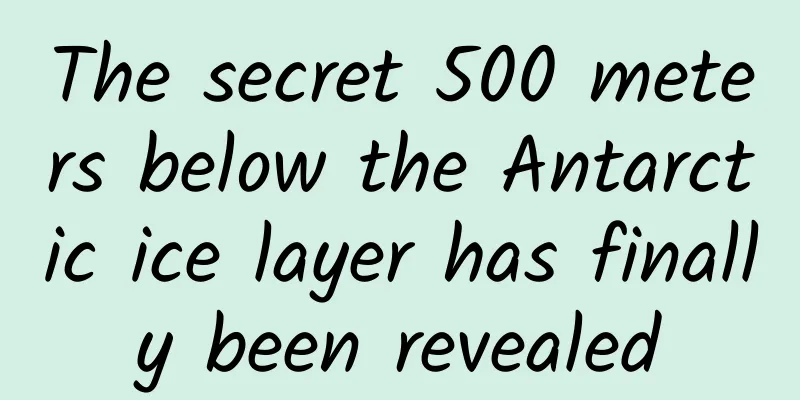The secret 500 meters below the Antarctic ice layer has finally been revealed

|
By Harry Baker Translated by Peng Rong Proofread by Wang Yu A never-before-seen ecosystem lurks in an underground river beneath the ice of Antarctica. Researchers recently unveiled this hidden world by discovering swarms of tiny shrimp-like creatures in a dark, jagged cave. Researchers have discovered schools of tiny shrimp-like creatures in underground rivers. Photograph: NIWA/Craig Stevens Scientists have discovered a secret underground habitat beneath the Larsen Ice Shelf, a huge floating ice sheet that clings to the east coast of the Antarctic Peninsula and was the site of the world's largest iceberg in 2021. Satellite photos show an unusual groove near where the ice shelf meets the land, which researchers described in a statement as an underground river. The team used a powerful hot water hose to reach the cave, about 500 meters below the ice. As the researchers threaded their camera through the icy passage into the cave, hundreds of tiny, blurry specks in the water obscured the video feed. At first, the team thought their equipment was malfunctioning. But after refocusing the camera, they realized that tiny crustaceans called amphipods were gathering just outside the frame. The discovery caught the team off guard, as they had never expected to find any signs of life so far beneath the ice. "To have all these animals swimming around our camera clearly meant there was an important ecosystem process going on there," Craig Stevens, a physical oceanographer at New Zealand's National Institute of Water and Atmospheric Research (NIWA) in Auckland, said in the statement. Stevens added that the discovery of the secret shrimp grouping structure had the team "jumping up and down with joy." Experts have long suspected that there is a vast network of rivers, lakes and estuaries beneath Antarctica, but until now, little has been learned about the characteristics of this network. This new discovery is all the more significant because it was previously unknown whether there was life beneath the ice. Lead researcher Huw Horgan, a glaciologist at Victoria University of Wellington in New Zealand, told the Guardian: "Sampling and observing this river is like being the first person to enter a hidden world." Horgan first spotted signs of the subterranean structure in 2020 while looking at satellite photos of the area. It looked like a long depression or trough extending above the ice, a sign of an underground river. However, Stevens said that although it was obvious in satellite images, the trench was not initially found on the surface. "But then we found this small, gentle slope and guessed we had found the right location." After sending the camera into the river, the team was surprised to find that the cave looked very different from what they had predicted. The researchers had expected the top of the cave to be smooth and flat. But instead, they found that the top was very uneven, with many steep ups and downs. The cave was also much wider near the top. "It looks like a piece of bread with a bulge at the top and a narrow slope at the bottom," Stevens said. The top of the underground cave is uneven. Photo credit: NIWA/Craig Stevens The researchers also unexpectedly discovered that the underground water column split into four or five different layers of water flowing in opposite directions. Stevens said: "This changes our current understanding and models of these environments. We will work hard to understand the significance of this." The team arrived above the hidden underground river in time for another intriguing observation. The researchers set up camp days before Tonga's record-breaking eruption on January 15. The massive blast created powerful pressure waves that rang like a bell through Earth's atmosphere, and sensors the researchers placed on the ice recorded similar pressure waves traveling through the subsurface. "It's pretty remarkable to be able to track the effects of a Tonga volcano erupting thousands of kilometers away," Stevens said. "It reminds us how connected the entire Earth is." The scientists will continue to study this newfound underground ecosystem and hope to learn more about how nutrients in the water circulate through Antarctica's groundwater network to sustain the rich life systems there. However, researchers are also concerned that even hidden ecosystems like this one could be at risk from the rapid warming caused by climate change. Stevens said: "The climate is changing, and some key points are yet to be discovered by the scientific community. But it is clear that huge changes are happening." Source: Global Science Original link: https://www.livescience.com/hidden-ecosystem-under-antarctic-ice |
<<: Who is a gentleman and who is a villain? Confucius said it all in three sentences!
>>: What is LSD? It once made Steve Jobs addicted
Recommend
Review of the operation of Xiaohongshu’s popular community!
I had nothing to do during the recent epidemic, s...
Should companies develop WeChat mini-programs?
Should companies develop WeChat mini-programs? Do...
Apple App Store makes a big move! Allowing developers and users to use third-party payment methods
This article is reprinted with permission from AI...
It is beautiful and long-lived, but it brings disaster to its life
Three hundred million years have passed. Since ap...
Yiche Ranking: Car Export Sales Ranking in October 2024
Recently, Yiche.com released the ranking of auto ...
The secrets to customer acquisition, conversion and repeat purchases in the P2P industry are all written here!
The P2P industry is so hot nowadays that major on...
WeChat launches new feature, "provoking" the three major operators, netizens: overestimating their capabilities
In today's mobile Internet era, the "cei...
Comprehensive understanding of Mobile Backend as a Service (MBaaS)
【51CTO Translation】What if you could build a comp...
Abstract types and methods in Swift
In object-oriented programming, an abstract type ...
The largest Apple delisting incident in 2018: more than 40,000 apps were removed from the Chinese region in a single day!
Today (June 27), the App Store showed a large-sca...
Super shorthand for RecyclerView adapter
[[144456]] RecycleView is a new control. It stand...
Apple releases new iOS 12.3 beta: Improved speed and stability
Apple has released the fourth beta version of iOS...
I spent thousands of dollars on a 5G phone, but why is the Internet speed still so slow? The answer is out
I believe many people have encountered this probl...
How to promote online for free (low cost) (Part 1)
Recently, many people have asked me a question, h...









